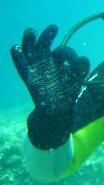The open water adventure went fairly well this weekend. Navigating Phenom (NP) and I had two groups of divers to take through their certification dives. The weather was great, but the visibility was poor. The two groups of divers performed their skills and most did quite fine.
There were the inevitable equipment challenges to deal with. Wetsuits that did not fit, lost masks, underweighted, overweight, regulator free flows and so on. NP and I managed to work through the problems and get everyone squared away. We had to make many trips back to the van to get larger
BCD’s, smaller weight belt, more weights and all kinds of odds and ends. Some of the students would wait until just before we were about to enter the water before telling us of some equipment issue. Of course we had to then take off the
BCD, weight belt etc, make our way back to the van, retrieve the equipment and help the student.
The worst of the equipment issues were related to adequate weighting. When we give out the weight belts initially, we make an educated guess as to how much weight each person would need. The weighting depends on the build of the person, the thickness of the wetsuit and whether they are wearing hood and gloves. Mostly, we were fairly close with the weight guesses. The problem turned out to be that some students did not know or understand how to do a good buoyancy check. For example, some people told us that they sank too fast, so we removed a little weight. However once we started the first dive, they could not descend and we had to add more weight. I think that some instructors rush through the buoyancy check in the pool and it shows when we get to work with the students in the open water environment.
When it came time to perform the fin pivots, this instructor was not a happy man. Somehow a few of the students thought that a good way to start the fin pivot was to do a good push up off the bottom. The reason was that they forgot to become neutrally buoyant by adding air to their BCD’s. One student refused to lay face down on the platform to start the pivot. The student wanted to do the pivot in mid water. I had a difficult time getting him to start the pivot from the platform floor.
When we had our post-dive briefing, I told the students that the pivots were terrible and we would have to do them correctly the next day or else. Before the next set of dives, I explained in detail what my expectation was of what a correct fin pivot should look like. Fortunately, there was a dramatic improvement in the quality of the fin pivots and everyone did a much better job on the second day.
From my perspective, I do not fully understand why fin pivots are part of the certification process. I think that we can teach and test buoyancy control in many different ways. The teaching process should represent what an open water diver might encounter. That is why we teach mask flood and clears, regulator recovery and so on.
I have never, or seen anyone use a fin pivot in recreational diving. For example, NP is a good videographer and has awesome buoyancy control due to his long periods of pointing his camera at small marine animals. He might come close to doing a fin pivot while photographing, but mostly he keeps off the bottom. In fact, we stress to student divers that they should always keep off the bottom so as not to damage aquatic life. So again, I do not see the place for a fin pivot.
To teach buoyancy control we could concentrate more on hovering skills and some other exercises that more closely mimic what a diver could encounter in the open water environment.
 Anyone familiar with masks will know that the first thing you do after buying a mask is to rub non-gel toothpaste on the inside and outside of the lenses. The reason is that the manufacturers apply a coating to the lenses to protect them and make them look clean and bright. Somehow, the toothpaste treatment does not always do a good job of getting the protective coatings off.
Anyone familiar with masks will know that the first thing you do after buying a mask is to rub non-gel toothpaste on the inside and outside of the lenses. The reason is that the manufacturers apply a coating to the lenses to protect them and make them look clean and bright. Somehow, the toothpaste treatment does not always do a good job of getting the protective coatings off.



